OK, I know there are skeptics out there including many of my dear colleagues. Though it seems that at least some of my photos are making an impression. So here is another little photo tour through bare-rooting – this time with a bigger tree.
This demonstration was given at the 2006 ISA conference in Washington. This is a good sized tree…

…that we plopped into a Rubbermaid watering trough after removing the burlap…
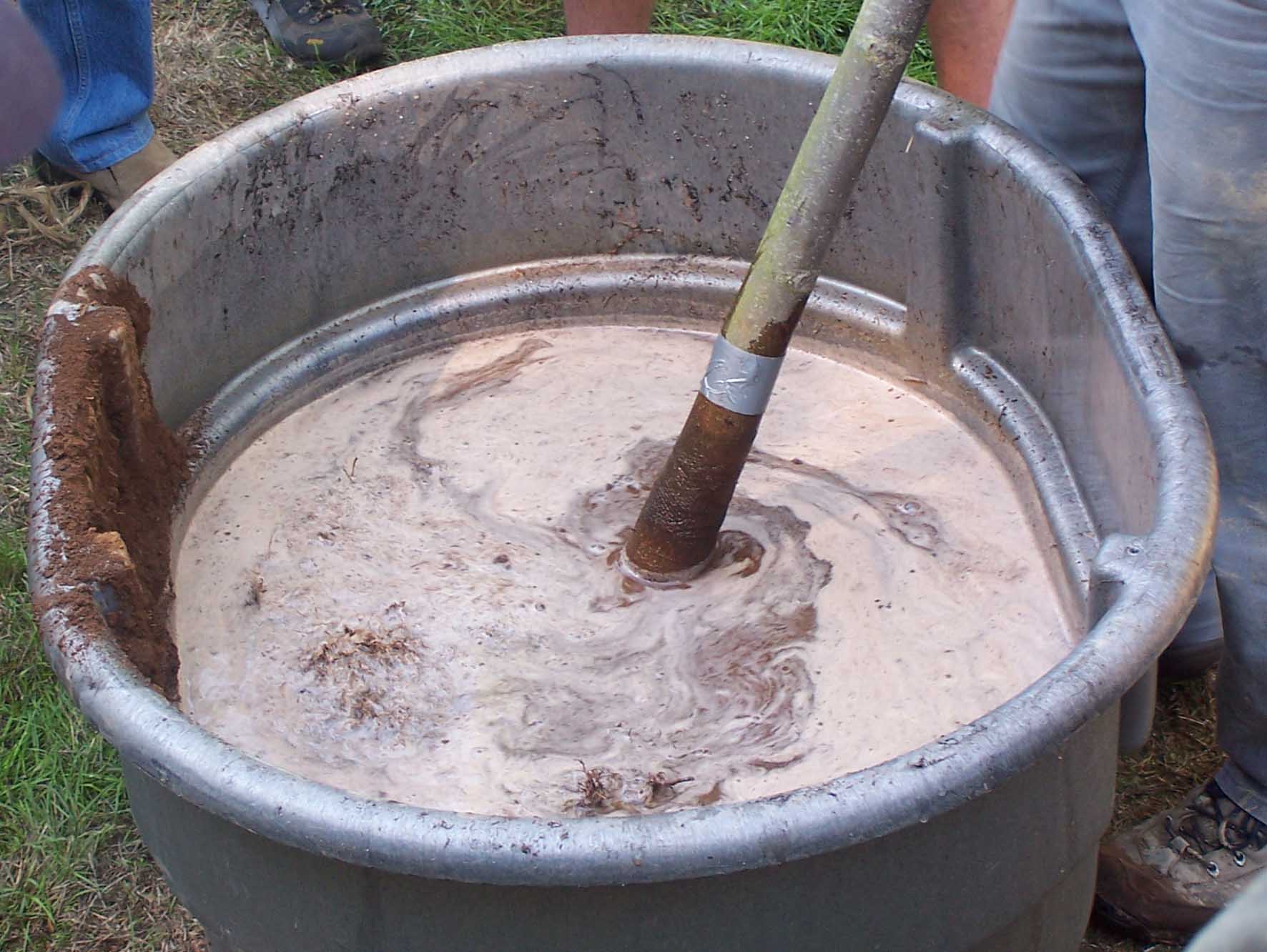
…and washed off all the clay. It is deceptively easy to do.
Oh! I almost forgot! We put some duct tape around the trunk just above the burlap before we started this procedure. Look where the tape ended up:
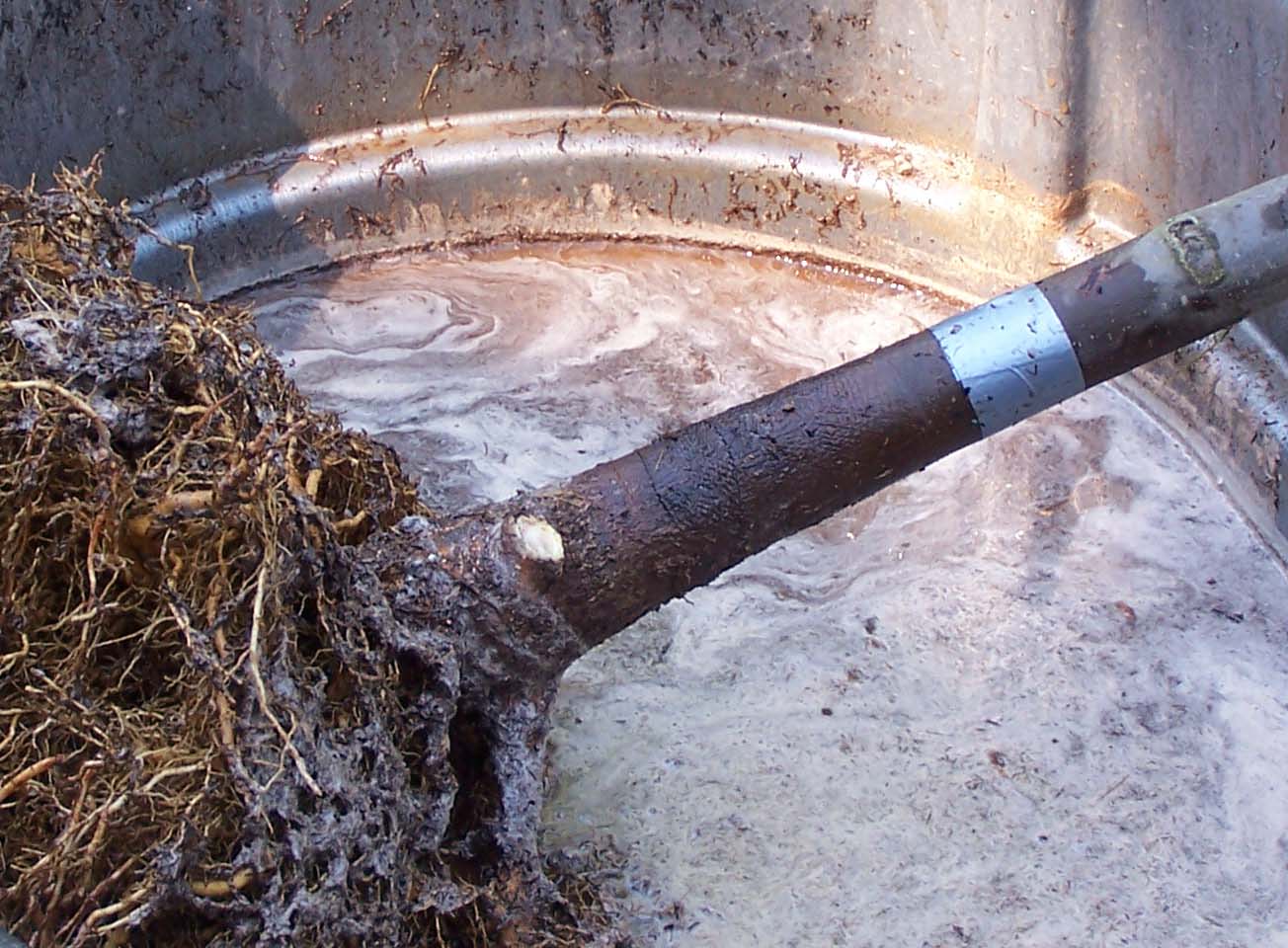
So there is another really compelling reason to bare root trees. Had we not, this tree would have been planted 10 inches below grade. But I do have to say the burlap made pretty patterns on the tree:
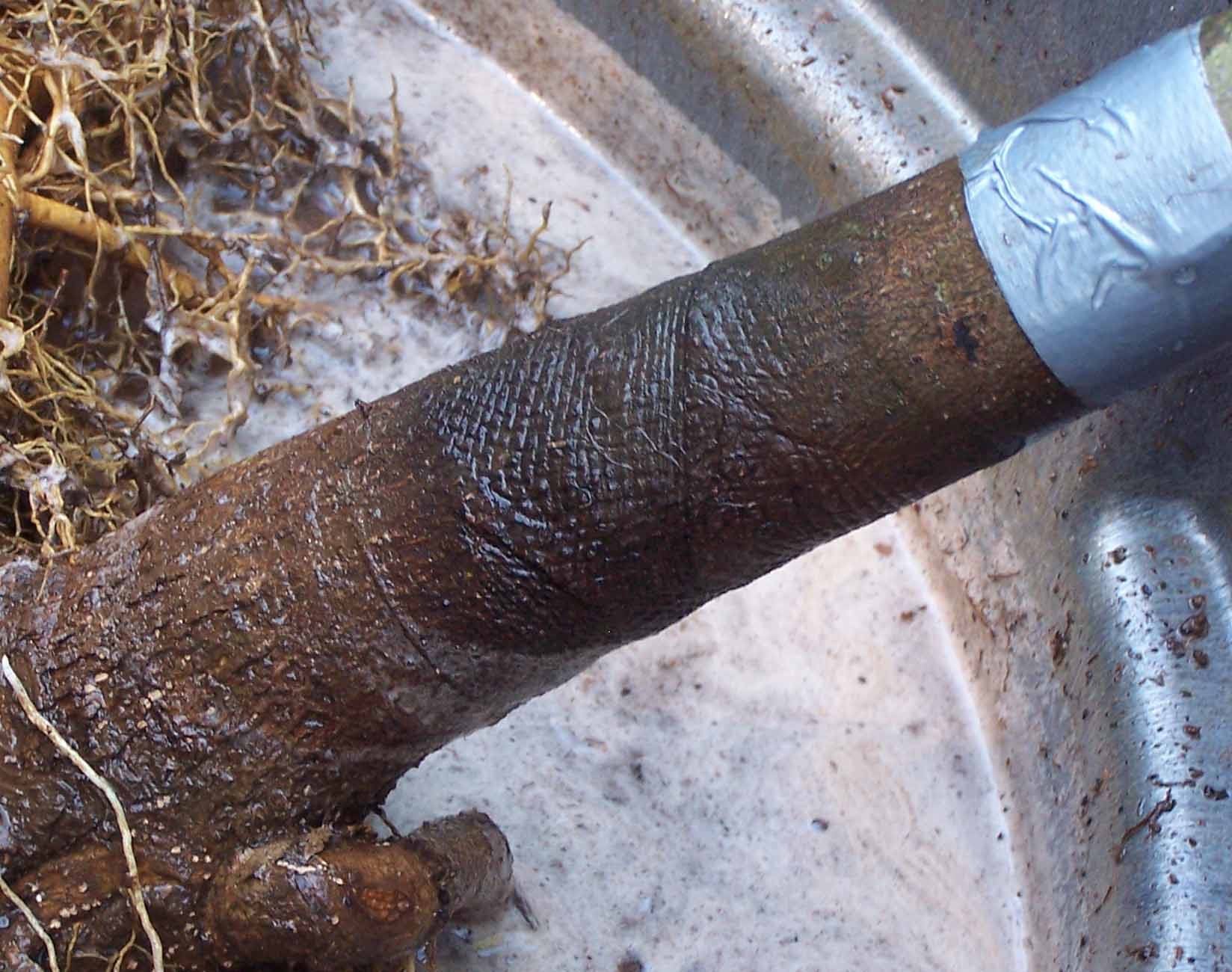
Another plus – with the clay gone, these trees are really easy to pick up and move around!
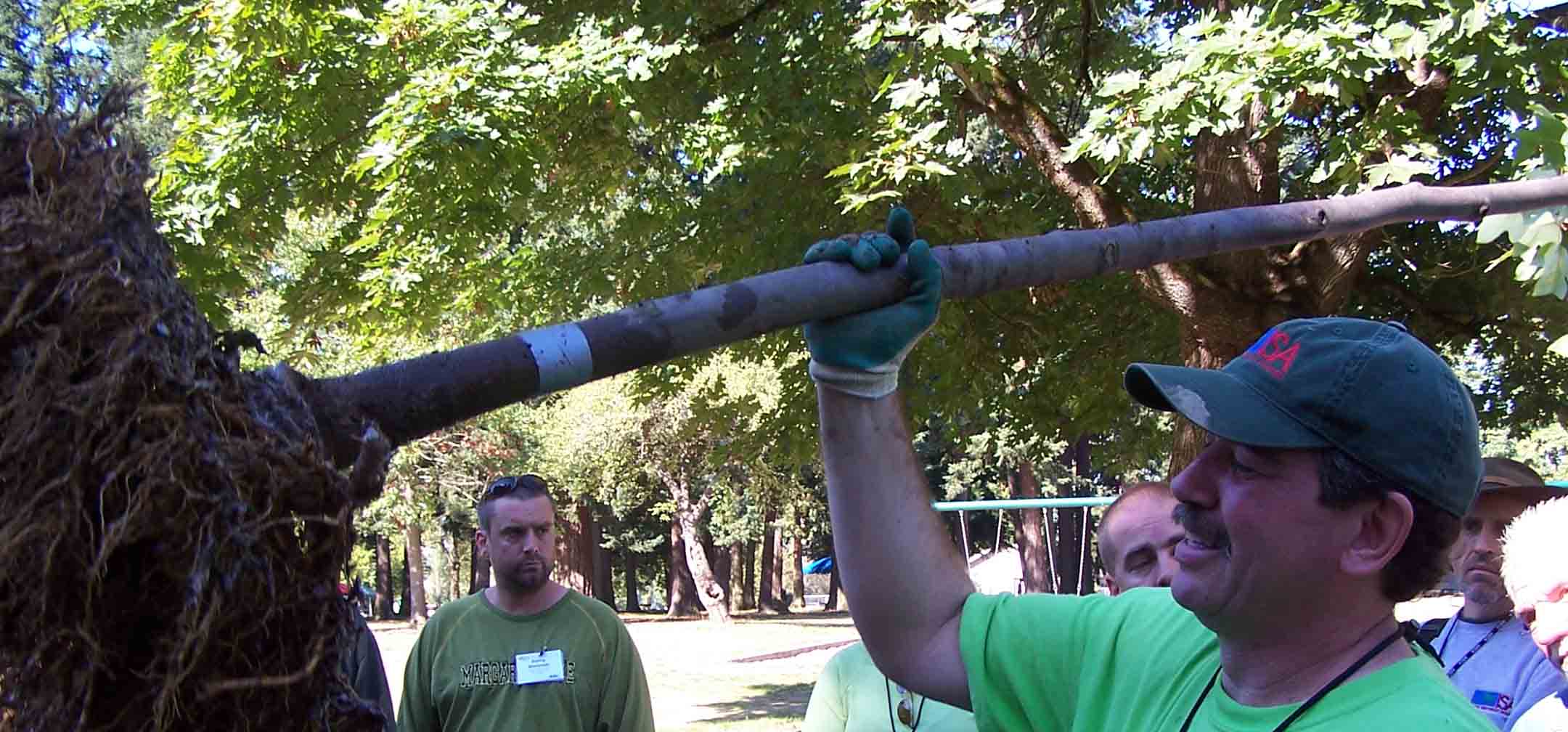
And it didn’t need staking once it was mudded in…

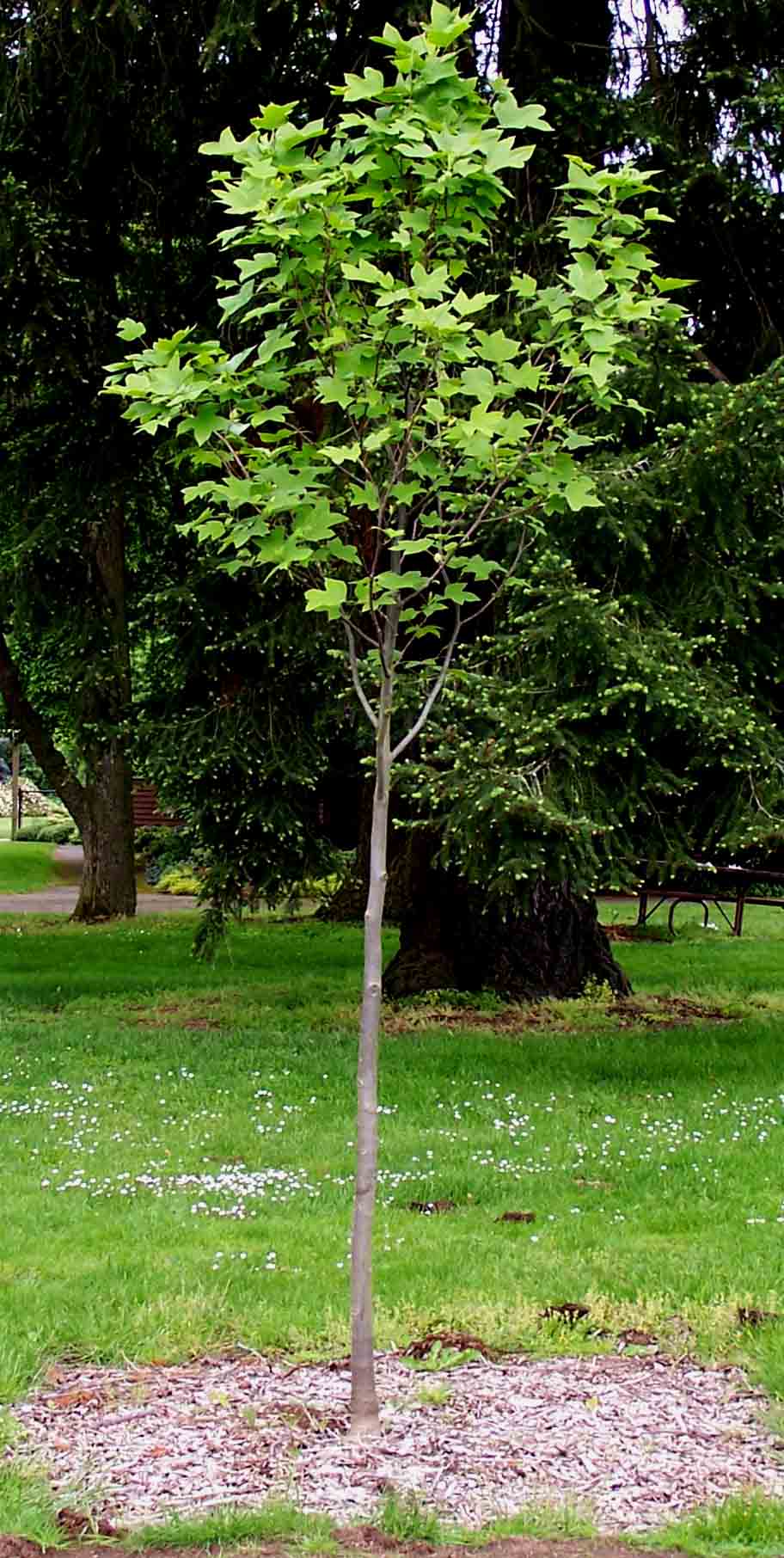
And it looked great seven months later with little to no maintenance and lives happily ever after. The end.
We generally use a metal probe to test how deep the uppermost roots are and then scrape the top portion of the soil-ball off with a flat bladed shovel before planting — which has worked very well for us. How long before you assaulted this poor trees clothing had it been harvested? I'm surprised to see roots growing out of the burlap.
Hi, thanks for the blog. Can someone maybe do an article on potting soil? Do you recommend bare-rooting these as well? Us poor apartment owners only have clay pots to work with….
Jeff, I have no clue when the tree was originally dug. It was purchased by the ISA from a local nursery, who (I'm assuming) got it from one of the giant out of state producers.
And I personally would rather have my delicate roots washed off rather than scraped with a shovel! Ouch!
Joe, welcome to the blog! I think a post about potting soils would be great (in fact I've been toying with the idea of researching potting soil information for a while…). In answer to the second question – if you are planting into a container, I would wash the roots only as you are going from the purchased plant to your own container. The roots are going to circle eventually in any container, and if the plant is living its life out in a container, it's probably not worth root washing every time you pot up. It's a good question!
I still have a hard time trying to convince landscapers who do my installs to remove the burlap! I think this sounds like a great idea and I would definitely try it out.
Thanks for your posts about washing roots. I recently bought a small Viburnum and decided to try your method (I'm always up for trying new things). I was glad I did. After the first layer of dirt came off I could see the roots circling around. I didn't spot them before the wash so under the 'old' technique into the ground they would have gone, possibly resulting in a failed planting.
After washing the root ball I was able to straighten out the girdling roots (I actually dug channels away from the original hole to stretch them out). I think the poor plant has much better odds now. Thanks again!
Welcome Shira and Diana! Shira, let me know how it works out and if you've got questions as you go. Diana, I'm glad to hear this seems to have worked for you. The channel approach is a good idea to hold those woody roots in place. You'll have to keep us informed on how your Viburnum does.
After a L.C-S. seminar and a meeting with Jim Flott, I was all gung ho about root washing. My colleague did it on some Carpinus and a Quercus coccinea planted in eastern Washington in the fall. They failed miserably. Only one survived. It could have been technique, but I don't think so. I think it was species specific. I still favor the root washing method, but check a list of "hard to transplant" trees before doing it on every tree. Cornell's pub on bare root method has good lists of which trees do well bare root.
Thanks for the input, Paul! I'd be curious to hear from Jim Flott, Bonnie Appleton and others that are either researching this practice or have had anecodtal successes or failures. Are there any trees and shrubs that just don't make it? (I have only lost the one little Stewartia that I mentioned in another post, since it had a completely fused root ball. So I haven't run into species-specific problems.)
Like the idea of washing away the roots but a couple of practical observations:
I would only do this when the trees/shrubs are still dormant (early spring) or at least going into fall. This isn't practical for late spring/summer installs.
Also you will have pay more attention to the backfilling process – there's the potential to create sizeable air pockets, a death knell for any plant.
I think it has good applications for small b&b trees & shrubs and possibly containerized plants but not large ones, if time/budget allows.
I agree, SJ – fall/winter is the best time for transplanting, period. But sometimes circumstances force you to plant under adverse conditions. I've done this in late April and it worked fine, though it's stressful on the plant (and the person!).
If you use the old technique of "mudding in" you will avoid air pockets. This involves putting soil over the roots, washing it through the system, then adding more soil until all pockets are filled. Best of all, this causes the soil to envelope the roots and holds them tightly as the water drains away. This is why staking is often not necessary.
As you can see from the photos, we've done B&B trees that are relatively good size. Don't know if anyone has found a limit yet…
Whoa! hold on there! For people planting in the West there's no question that fall planting is best, but here in the midwest spring is best (fall is second best). When I lived in the South I also learned that fall was the best time to plant, and I brought that with me to Minnesota. After a few years I quickly learned that the fall was a pretty good time to plant, but not nearly as good as a spring planting. Also, in terms of the root washing — I'm still not convinced. In terms of the root washing I'm starting to wonder if success isn't tied, not only to tree species, but also to the amount of time that a tree has been sitting around in burlap before it's planted. The longer it sits around in the burlap the more extensive its root system becomes and the more likely it is to handle the root washing well. I'm also starting to think that location is important. The quality of B&B stock here in Minnesota seems worlds better than what Linda is seeing in Washington.
I still stick by fall planting, and that's after spending 8 years in Buffalo. As long as the root zone was mulched, it still gave roots a good start before spring leaf break.
There's a climate issue here as well related to rainfall. You all get a lot more rain in the summer than we do. It's dry as a bone from June through October, in general. Spring planting is followed by summer drought. It's not a good combination. So those of you with wetter summers and cold winters, sure, spring might work out for you (but will probably require more irrigation, too).
You'll have to take a look at my bare rooting photos of my Cercis again, Jeff. There were NO fine roots at all. My guess was this was a crappy bare root that would have been thrown out, but instead they stuck it in a B&B and shipped it off. I don't think it makes any difference how long it's been in the bag. And all that aside, you still are going to have the issues of (1) things being planted too deep because the root crown is buried in the bag, (2) soil texture differences between the B&B and native soil, and (3) potentially poor root systems. You may not have #3 in Minnesota, but what about the first two issues?
Hmmm — My first year in MN Bert Swanson (my predecessor here) said sure — go for it — but not with…and he listed about 4 species. I though he was full of bull and so planted about 5 birch (one of the species he named). He laughed at me. I lost 4 of the 5. Sure, we have #1 — as I mentioned previously, the knowledgeable gardener/landscaper tests the top of the ball with a probe, digs off the top of the ball (down to the uppermost roots) and plants — no big deal — the Minneapolis Park Board who we work closely with has done this with literally thousands of trees over the last 10 years or so — with no problems related to this methodology. In terms of the soil texture differences — sure, we have these to some extent — but not like what you've mentioned (clay into sand — I saw quite a bit of that in GA). I can honestly say that here, in Minnesota, I've never seen it become a major problem. If the tree is healthy the roots soon grow out of the B&B soil and into the native soil. Finally, root systems are very different in trees that are just harvested vs. those that are forced to remain in ball for a long period of time. The root pruning provided by the spading forces additional fine roots to develop. Knock open a ball a week after harvest vs. 6 months after harvest and there's a world of difference (though differences are certainly species dependent).
Whoops — for the first sentence in the comment above I meant to say that Bert told me not to plant Birch in the fall!
I think we can agree that it's ok to disturb the root ball, if only to take off the excess soil on top of the root crown. However, you know that the retail industry does not necessarily like people doing this and will often void the warranty if the customer does alter the root ball in any way. So if we (for now) forgo the obvious climate, soil and plant quality difference – how do we get the retail nursery to modify their procedures and warranties?
Yes — I agree with that statement (hooray! common ground!) Great question: I mostly deal with municipalities (where a guarantee isn't an issue) and landscapers who guarantee the stock that they plant (which often doesn't come from the garden center). In terms of garden centers….Veiled threats!?! (not so veiled threats?) I guess the answer is education — Do your retailers deal much with the American Standards for Nursery Stock? It provides some guidelines.
Yes, I think most retailers do use ASNS. But as you know it's difficult if not impossible to assess root quality without some destructive sampling upon the arrival of a shipment. Rita Hummel has been pushing for YEARS for landscapers and retailers alike to have a solid contract that states (1) that any shipment will have a portion (less than 1%) of the plants bare rooted to assess root quality and (2) that if the samples fail, the shipment is rejected. As far as I can tell (based on the crummy quality of plants I see for sale or installed by commercial landscapers), no one does this. The education is there. The incentive to use it, not so much. Customers have to start pushing from their end to make things change, I think.
The circle swings back to education again — that is, educating the customer, so that they do start pushing back. In my arena, that's the landscape architects specifying the plants, and the contractors buying and planting them. It's a tough slog — the contractors want to work fast, and aren't quite as concerned about the longevity of the plants, and the landscape architects, most of them, are worrying about other things (which is unfortunate, as our landscapes, and how they survive and thrive, are the most visible evidence of the quality of our work). In my experience, garden centers figure that the problem belongs to the contractors, LAs, or owners once the plant leaves the center; again, longevity and survivability (once that one-year guarantee period is over) don't seem to be such big concerns for them.
As an employee of a garden center, I'm well aware of the issues of educating staff. I'm a bit of a maverick here when it comes to reccomended practices however, and coworkers are sometimes surprised at some of my reccomendations to customers. I'm more surprised that my coworkers still reccomend what they do even after attending short courses and other industry functions, usually with a heavy Extension or presence. In my opinion, I think the forms of education (short courses and such) we receive don't focus enough on a single subject, such as the issue of soil amendments. Most of our staff is comprised of "certified horticulturists" (through our industry association), but you wouldn't know it based on the range of information being given out. I've had a coworker who also happened to be a certified arborist tell a customer to plant with mulch and sand with no native soil. Basically, I don't know of any ways to educate staff any more than has already been done. Perhaps, Extension personnel talking to the management of these businesses directly and offering to talk with the staff is one way. I for one would really enjoy that. I have our local agent come by every month or two to look at a few things and I spend most of the time picking his brain about other things. Some of my coworkers wouldn't do that. I'm not sure if it has to do with a lack of interest or what. In short, I guess accessibility to the staff of garden centers would be a huge step, but I do understand Extension staff is not there for that.
That's an excellent point, CP. Personally, I have given short courses at local nurseries on request – but I don't get many requests! I don't know where you are located, but you might suggest something like this: offer to host a short course at your nursery that would have CEU credits. Charge people a nominal fee (usually not a problem when CEUs are involved). Get your local agent to give the course, and offer him an honorarium. I think there are some creative ways to get the education you need even when university budgets don't encourage their faculty to do more outreach.
Linda, that's not a bad idea. I am becoming a member of my county's Extension Leadership Council. I'm not sure what to expect, but from talking to the Agent, any reccomendationg on improving outreach is most welcome.
Never thought to rinse the tree before replanting. I am actually in Canada, and nowhere near your university, but I stumbled across your advice – thanks for posting!